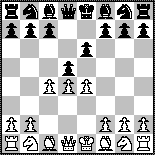Ideas Behind the DDG
B

|
"All openings are sound below master level." (Lombardy)
"Like the BDG, it is widely condemned. Still, ..." (Tom
Purser)
|
In Spanisch bis Französisch (1974), Paul Keres mentions
bizarre systems against the French Defence. In addition to 3. Be3, he
gives the following line (translation from German).
IM John Watson agreed with Keres in his brief
analysis.
"3. c4 (this pawn sacrifice is not correct)
dxe4 4. Nc3 Nf6 (possible are also 4... Bb4 and 4... f5)
5. f3 c5 6. d5 exd5 7. cxd5 exf3 8. Nxf3
Bd6,
and Black has good position with a healthy pawn."
Chessmaster 3000 gives the following
English Language Analysis:
- The Chessmaster recommends: Pawn takes pawn on e4.
- Analysis: Your pawn captures pawn on e4. White responds by moving
the knight to c3, which threatens your pawn on e4. You move your
knight to c6. White responds by moving the knight on g1 to e2.
- As a result of this line play, you win a pawn. In addition, your
attack potential is somewhat increased. Also, the development of
White's pawns is somewhat weakened.
In my view, 3. c4 is based on these ideas:
- White can ruin Black's plan to play a semi-closed game: one in
which the center files generally remain closed, thus enabling Black to
build up a solid position in the center.
- White can play Bc2 and Qd3 to attack h7, which has been proved
lethal if Black dares castle kingside. The c4 move makes the DDG
different from the
BDG, where White often plays Bd3 and
Qe1-h4. In the BDG, White can also safely castle queenside.
- Black is prevented from playing Nd5, which is typical in the
Alapin French, where White has played Be3.
If Black plays c5, White can advance to d5, thanks to c4.
White can also give a check with Qa4 if Black plays Bb4.
- White plays f3 to get the half-open f-file, and after castling
kingside, the rook is ready to attack. If Black does not play exf3,
White can play fxe4, either regaining the pawn, or winning a tempo
after Nxe4, Qd3, Nf6.
- If Black plays Bb4, White usually gets the bishop pair. Bg5 is
often decisive in pinning Nf6
(DDG à la pin).
- The tendency to create sharp attacks is a way to avoid long
endgames. The name of Diemer's book that introduced the DDG
crystallizes it: Towards Mate from the First Move.
I have tried to describe the purpose of all the
pawns and pieces
in a typical DDG game.

